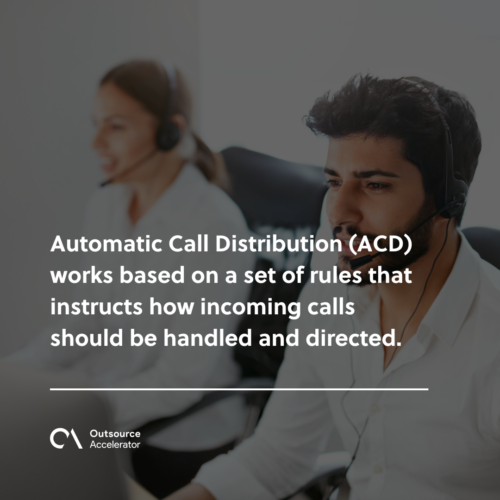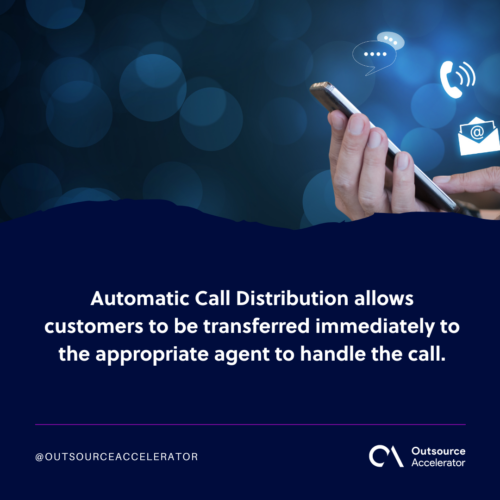What is automatic call distribution?

It is common knowledge that call centers handle huge volumes of calls on a daily basis. This has remained quite challenging for agents, especially when customers call at the same time.
In most cases, callers that wait long in queues usually end up hanging up the call or become frustrated and irate.
But thanks to technological innovations, call centers today are able to shy away from those kinds of scenarios.
By installing an Automatic Call Distribution (ACD) system, call centers are able to elevate their overall efficiency and productivity.
As you can see, a bad customer service experience may cause a lasting negative impact on one’s business. Call centers serve as a direct point of contact between a brand and its customers.
This is why companies always look for better ways to improve their call center services and performance by investing in top-notch tools and technologies.
But what is ACD, to be exact? That is the question we will answer in this article
What does ACD stand for in a call center?
Automatic Call Distribution, or ACD, is a telephony system designed for inbound calls.
It automatically receives incoming calls and routes them to an available and appropriate agent.
Each call distribution can be based on specific parameters like the longest available agent, business hours, and IVR selection.
Callers will also be put in queue if there is no available agent at the moment. Apart from helping inbound call centers manage their calls properly, it also takes customer experience a step further.
Additionally, ACD automatically connects callers to the right agent to cater to their kind of needs efficiently.
Moreover, an automatic call distributor has to work with an Interactive Voice Response (IVR) before calls are routed or queued.
Interactive Voice Response (IVR) vs Automatic Call Distribution (ACD)
IVR and ACD are two inbound call center tools that are usually interchanged with one another.
An Interactive Voice Response or IVR is an automated phone system that enables callers to interact with voice prompts.
It determines the callers’ queries and the type of assistance they need before they are routed to the right agent.
IVRs direct callers to press certain keys on their phones to determine their issues or questions.
After which, the ACD will receive the callers’ responses and transfer them to the appropriate agents to handle the call.
How Automatic Call Distribution (ACD) works
ACD works based on a set of rules that instructs how incoming calls should be handled and directed.
Basically, the primary goal for ACD is to be able to route callers to the most suitable agents or departments.
The overall call delegation process starts with identifying the purpose of the call. Caller IDs may also be used to collect specific caller information like their location.
Next is call queuing, which sets the order of calls based on factors like – the type of query, waiting time, and call status.
The last step is when the call is routed to the right people.

4 common types of call distribution
Each call is dispersed in different ways, here we have listed down the common types of call routing:
1. Fixed order call distribution
For this type, incoming calls are distributed according to a fixed arrangement of agents. If the specific agent to handle the call is busy, it will then be transferred to the next agent on the list.
2. Simultaneous call distribution
This is also known as Ring groups, in this type, a specific call is routed to all available agents. Whoever answers the call first will be the one to handle the customer.
In simultaneous call distribution, agents may tend to incur different workloads as other agents may end up taking in more phone calls than others.
3. Round-robin call distribution
Round-robin call distribution enables agents to have equal volumes of calls to be handled every day. All agents will take turns in answering calls in a continuous rotational manner.
For example in four agents, if Agent 1 takes a call, Agent 2 is required to take the second call, and the cycle goes on.
4. Longest available call distribution
This is a time-based type that tracks the agent’s availability and routes the call automatically. This type helps prevent agents from receiving an overwhelming amount of calls. It makes sure that every agent has an equal share of the workload.
How does ACD favor your business?
Now that we have discussed the basics of ACD, let’s get to know how this telephony system benefits one’s business:
Customer experience
As we have mentioned prior, ACD allows customers to be transferred immediately to the appropriate agent to handle the call. This ensures that the customers can be directly attended to.
On top of that, the right agents will be able to provide the correct assistance or solutions to their problems or issues.
In turn, it will result in high customer satisfaction, at the same time greatly improving the customer experience.

Workforce management
Maintaining incoming calls in a systematic manner helps save more time for agents to perform other tasks. More so, it ensures an equal delegation of workload among the agents.
Coaching and agent performance
Agent coaching becomes easier with the help of ACD’s call monitoring functions. Managers will be able to track and check each agent’s call performance in real-time.
Afterwards, provide comments and feedback for improvement.
Since ACD can determine the customers’ reasons for calling prior to call distributions, agents will know what to do once they take the call.
Further, the right call distribution helps reduce transfer calls, at the same time, it also improves the agents’ first call resolutions.







 Independent
Independent




